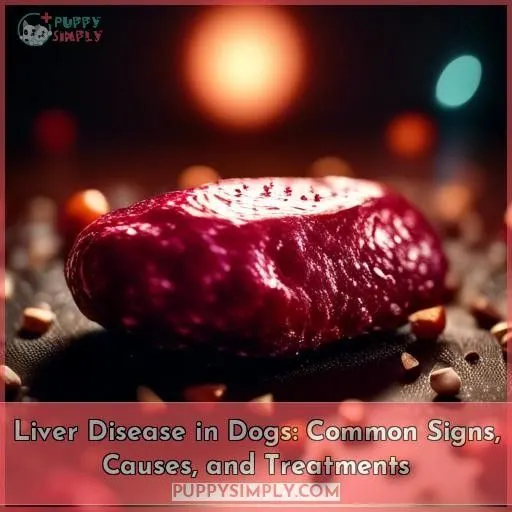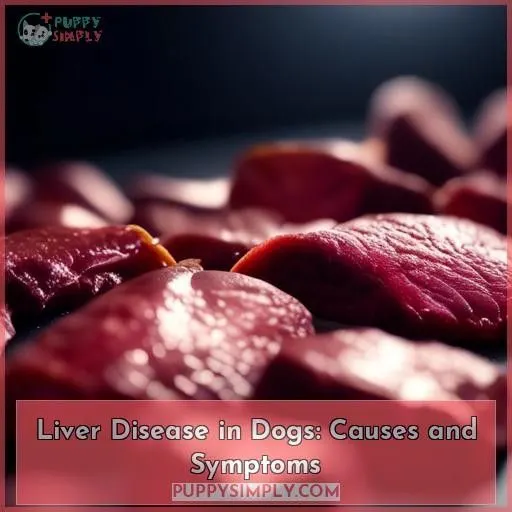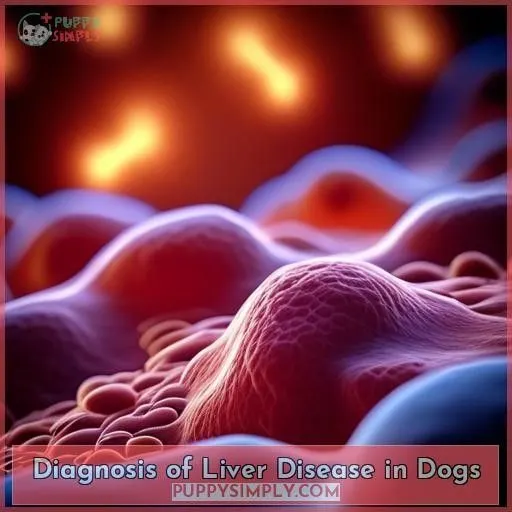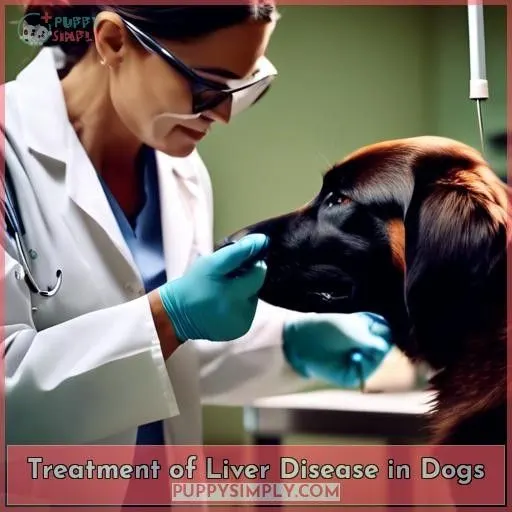This site is supported by our readers. We may earn a commission, at no cost to you, if you purchase through links.
Liver disease is a common issue in dogs that can cause concerning symptoms like loss of appetite, weight loss, vomiting, and increased thirst. It can stem from aging, genetics, infections, trauma, or certain medications.
To diagnose liver disease, your veterinarian will likely perform blood tests, x-rays, ultrasounds, or even a liver biopsy.
Treatment options include dietary changes, supplements, antibiotics, and sometimes surgery. Common liver conditions in dogs include ascites, clotting issues, bacterial infections, and fibrosis.
If you’re concerned your dog may be showing signs of liver disease, it’s best to consult your veterinarian for a proper evaluation and recommended course of treatment.
Table Of Contents
Key Takeaways
- Liver disease in dogs can cause symptoms like loss of appetite, weight loss, vomiting, diarrhea, increased thirst, and an unsteady gait.
- Diagnosis involves blood tests, X-rays, ultrasounds, and liver biopsies. Treatment includes diet changes, supplements, antibiotics, and surgery.
- Common liver conditions in dogs include ascites, clotting issues, bacterial infections, and fibrosis.
- Breeds like Bedlington Terriers, Doberman Pinschers, Skye Terriers, and West Highland White Terriers are predisposed to specific liver conditions due to genetic factors.
Liver Disease in Dogs: Causes and Symptoms
As a dog owner, it’s essential to be cognizant of the prevalent signs of liver disease, such as loss of appetite, weight loss, vomiting, and diarrhea. Appreciating the possible causes, ranging from aging and genetics to infections and particular medications, can assist you in identifying the problem and seeking timely veterinary assistance.
such as loss of appetite
When your furry friend turns up their nose at dinner, it’s not just pickiness. Loss of appetite can signal liver disease in dogs, stemming from causes like gallbladder agenesis or bile duct obstruction. It’s a symptom that shouldn’t be ignored.
weight loss
Weight loss in dogs can be a sign of liver disease, as the liver is responsible for maintaining a dog’s overall health and metabolism. Rapid weight loss in dogs can be caused by various factors, including dental issues, stress, gastrointestinal problems, and liver disease.
If your dog is losing weight, it’s imperative to consult a veterinarian to determine the underlying cause and develop an appropriate treatment plan. In some cases, weight loss may be a symptom of a more severe medical condition, such as liver disease, which can lead to a range of symptoms, including loss of appetite, vomiting, diarrhea, increased thirst, and an unstable walk.
vomiting
Vomiting in dogs can be a sign of liver disease, which is often characterized by a variety of symptoms such as loss of appetite, weight loss, and jaundice. Vomiting can be caused by a number of factors, including nausea, dehydration, electrolyte imbalance, and the presence of toxins in the gastrointestinal tract.
If your dog is vomiting, it’s important to consult with a veterinarian to determine the underlying cause and to make sure it receives appropriate treatment. Diagnostic tests may include blood tests, liver function tests, and imaging techniques such as ultrasound or X-rays.
Treatment options for liver disease in dogs may include dietary changes, supplements, antibiotics, and surgery, depending on the severity of the disease and its underlying cause.
diarrhea
Diarrhea is a common symptom of liver disease in dogs. It can be caused by a variety of factors, including liver damage, inflammation, and infections. When the liver isn’t functioning properly, it can lead to a buildup of toxins in the body, which can cause digestive issues like diarrhea.
Certain medications and toxins can also damage the liver, resulting in diarrhea as a symptom.
Treatment for liver disease in dogs often includes diet changes, such as a higher carbohydrate, low-protein diet, and the use of supplements like lactulose to bind toxins in the gut. Antibiotics may also be prescribed to treat infections.
In severe cases, surgery may be necessary to remove tumors or cysts from the liver.
increased thirst
If your dog exhibits signs of heightened thirst, it could indicate liver disease. This ailment can stem from various causes, including dehydration, electrolyte imbalance, or underlying factors such as liver dysfunction or kidney disease.
It’s imperative to consult your veterinarian to ascertain the root cause and appropriate treatment.
Meanwhile, make certain your dog has access to fresh water to prevent dehydration.
and unstable walk
Your dog’s unstable walk could be a sign of liver disease. This symptom, along with others like tremors, seizures, lethargy, jaundice, confusion, and tracheal collapse, can be associated with liver disease in dogs.
The causes of liver disease in dogs can include sources like poisonous plants and herbs, leptospirosis, molds, untreated heartworms, and diabetes.
Diagnosis involves blood tests, X-rays, ultrasound, and biopsy. Treatment may include diet changes, supplements, antibiotics, surgery, and medication adjustments.
including aging
As a dog ages, their liver may become less efficient at processing toxins and metabolizing medications, leading to an increased risk of liver disease. This is a natural part of aging, but it can be exacerbated by genetic predisposition and exposure to certain toxins or medications.
To diagnose liver disease in dogs, veterinarians may use blood tests, X-rays, ultrasounds, and biopsies. Treatment can include diet changes, supplements, antibiotics, surgery, and medication adjustments. It’s essential to address liver disease early to prevent complications such as hepatic encephalopathy, which can cause seizures, disorientation, depression, and other neurological symptoms.
Some breeds, such as Bedlington Terriers, Doberman Pinschers, Skye Terriers, and West Highland White Terriers, are predisposed to specific liver conditions due to genetic factors. In these cases, early detection and management can markedly improve the prognosis.
In addition to aging, other causes of liver disease in dogs include exposure to toxins, infections, and certain medications. It’s imperative for dog owners to be aware of these risk factors and to monitor their pets for any signs of liver disease, such as loss of appetite, weight loss, vomiting, diarrhea, increased thirst, and unstable walk.
genetics
Just like inheriting your grandma’s twinkling eyes, dogs can inherit liver issues. Breed susceptibility, like in West Highland White Terriers, is a genetic predisposition. DNA testing and mutation studies help identify these risks, guiding us in managing their metabolic capacities and dodging metastatic tumors.
infection
Infections can cause liver disease in dogs, and it’s imperative to comprehend the symptoms, causes, diagnosis, and treatment of this condition. Symptoms of hepatitis in dogs may include swollen tonsils, eye inflammation, intermittent vomiting, and stomach pain. Infections such as canine hepatitis, leptospirosis, coccidioidomycosis, and histoplasmosis can result in liver damage.
Diagnosis of liver disease in dogs entails blood tests, X-rays, ultrasound, and liver sampling or biopsy. Treatment options encompass dietary modifications, vitamin supplements, antibiotics, surgical intervention, and medication adjustments. Preventive measures include vaccinations and evading exposure to contaminated environments.
Infectious diseases like canine hepatitis can be prevented through vaccinations, which are typically administered to puppies at approximately 7 to 9 weeks of age, with booster shots throughout their lifespan. It’s vital to maintain your dog’s protection by ensuring they receive regular vaccinations and booster shots.
trauma
Trauma can lead to liver disease in dogs, causing vessel abnormalities and acquired shunts. Recognize symptoms like loss of appetite, weight loss, vomiting, diarrhea, increased thirst, and unstable walk.
Prevention involves addressing the underlying cause and seeking prompt veterinary care.
Diagnosis may include blood tests, X-rays, ultrasound, and liver sampling or biopsy.
Treatment includes diet changes, supplements, antibiotics, surgery, and medication adjustments.
and certain diseases and medications
Medication side effects, poisonous plant ingestion, primary tumors, and certain diseases can all contribute to liver disease in dogs. It’s vital to be aware of these potential causes to guarantee early detection and proper treatment. If your dog is experiencing symptoms such as loss of appetite, weight loss, vomiting, diarrhea, increased thirst, or an unstable walk, it’s imperative to consult with your veterinarian for a thorough examination.
To diagnose liver disease, your veterinarian may perform blood tests, X-rays, ultrasound, or a liver biopsy. Treatment options include diet changes, such as a low-protein diet or a higher carbohydrate diet, supplements, antibiotics, surgery, and medication adjustments. In some cases, a liver transplant may be necessary.
Preventing liver disease in dogs involves avoiding exposure to toxins, such as certain medications, poisonous plants, and chemicals. Regular veterinary check-ups and vaccinations can also help preserve your dog’s liver health.
including blood tests
Blood tests are an essential diagnostic tool in detecting liver disease in dogs. These tests, such as a serum chemistry panel, liver function tests, and bile acids testing, help assess the liver’s function and identify any abnormalities.
Elevated liver enzymes, like ALT (alanine aminotransferase) and ALP (alkaline phosphatase), can indicate liver damage or inflammation. A low albumin or cholesterol level might also be a sign of severe liver disease.
Yellowing of the eyes and skin, known as jaundice, can occur when the liver isn’t effectively removing bilirubin, a by-product from the breakdown of red blood cells.
Diagnosing liver disease early is imperative, as it allows for timely intervention and treatment, which can improve the dog’s prognosis.
X-rays
After blood tests hint at liver trouble, your vet’s next move might be a peek inside with an X-ray. This abdominal imaging can spotlight liver abnormalities, revealing radiographic findings that suggest parenchymal disease without a scalpel in sight.
ultrasound
Ultrasound findings play a critical role in diagnosing liver diseases in dogs. Ultrasound examinations can help identify various liver conditions, including liver parenchymal changes, biliary system abnormalities, and portal vein issues. The severity of ultrasound findings can be classified into mild, moderate, and severe categories, with the latter two indicating significant liver damage.
In healthy dogs, more than 95% of them had mild ultrasound scores, while approximately 30% and 40% of patients with chronic hepatitis presented with mild and moderate changes in liver parenchyma, respectively. Notably, about 50% of animals with vacuolar hepatopathy and steroid-induced hepatopathy can be classified as severe ultrasound score**. Animals with tumor and hepatic fibrosis had moderate-to-severe ultrasound score categories, with approximately 75-80% of patients classified as severe score.
Ultrasound score was moderately associated with ALT and highly associated with ALP levels in dogs with liver disease. Additionally, gallbladder wall thickness is another important parameter that can be assessed using ultrasound. In fasted dogs under 40 kg, normal gallbladder wall thickness should be ≤1.30 mm.
such as diet changes
To manage liver disease in dogs, dietary changes are essential. Here are three key points to bear in mind:
- High-Carb, Low-Protein Diet: This diet helps ease the burden on the liver and can prevent hepatic encephalopathy.
- Vitamin Supplements: B vitamins, vitamin K, and vitamin E are vital for liver health and can be recommended by a vet.
- Antibiotics and Medication Adjustments: In some cases, antibiotics may be required to treat bacterial infections, while medication adjustments can help manage underlying conditions.
supplements
Supplements play an essential role in managing liver disease in dogs. Vitamin supplements, such as B vitamins, vitamin K, and vitamin E, can help support liver function and prevent deficiencies. Lactulose can bind toxins in the gut, reducing the risk of hepatic encephalopathy. Antibiotics may be prescribed to treat bacterial infections, while vitamin K can address bleeding issues.
antibiotics
When treating liver disease in dogs, antibiotics play a pivotal role in controlling bacterial infections that can worsen the condition. Antibiotic selection should be carefully considered to guarantee efficacy against the specific bacteria causing the infection and to reduce negative effects. Commonly used antibiotics include ampicillin, amoxicillin, cephalexin, fluroquinolones, and metronidazole, which are effective against enteric organisms.
Antibiotic resistance is a concern in dogs with liver disease, as they may be more prone to infections due to their impaired liver function. It’s essential to track antibiotic resistance trends and modify treatment accordingly.
Antibiotic side effects can include vomiting, decreased appetite, and diarrhea, which may be amplified by the underlying liver disease. To minimize these side effects, it’s crucial to monitor antibiotic dosage and interactions with other medications the dog may be taking.
In some cases, antibiotics may need to be administered for extended durations, such as in the management of hepatic encephalopathy, where metronidazole may be advantageous.
Antibiotic resistance can be a major challenge in patients with liver disease, and it’s essential to stay informed about the latest treatment options and strategies to prevent resistance.
surgery
In the fight against liver disease in dogs, surgical intervention can be a game-changer. From shunt closure to liver transplantation, it’s all about bleeding control and pain management. It’s like fixing a leaky faucet—complex, but essential for a happy, healthy pup.
and medication adjustments
With respect to the treatment of liver disease in dogs, medication adaptations are essential. Here’s what you should be aware of:
- Liver failure: Adjust medications to aid liver function and prevent further deterioration.
- Hepatic encephalopathy: Protein restriction might be required to prevent this complication.
- Clotting defects: Monitor for and manage any bleeding issues with vitamin K.
- Bacterial infections: Antibiotics might be prescribed to combat infections associated with liver disease.
Diagnosis of Liver Disease in Dogs
If your dog is showing signs of liver disease, your veterinarian will need to perform a series of tests to diagnose the condition and determine its cause. The first step is typically a blood chemistry panel, which will reveal any abnormalities in the liver enzymes, such as alanine aminotransferase (ALT) and alkaline phosphatase (ALP). A complete blood count (CBC) can also help detect anemia, which is a sign of chronic liver disease.
Your veterinarian may also recommend an abdominal ultrasound to visualize the liver and check for any irregularities, gallstones, or diseases of the gallbladder. In some cases, a liver biopsy or liver sampling may be necessary to obtain a tissue sample for further testing.
Additionally, your veterinarian may perform a serum chemistry panel, which will help assess your dog’s liver values and guide the veterinarian if liver disease is a concern. Advanced blood tests, such as liver function tests or screening tests for Cushing’s or other endocrine diseases, may also be recommended.
If your veterinarian suspects an underlying condition causing the liver disease, they may recommend additional tests, such as X-rays or urinalysis, to rule out other potential causes.
Treatment of Liver Disease in Dogs
Treatment of liver disease in dogs can involve a range of options depending on the severity and underlying cause. For mild cases, diet modification with liver supplements may be sufficient.
In more severe cases, hepatic encephalopathy may require surgical intervention or antibiotic therapy. Antibiotic therapy can also be used to treat bacterial infections associated with liver disease.
Additionally, diet modification may be necessary to prevent hepatic encephalopathy in dogs at risk.
Common Liver Conditions in Dogs
Liver disease in dogs can manifest in several ways, and understanding these conditions can aid in early detection and treatment. Some common liver conditions include:
Ascites: The accumulation of fluid in the abdomen.
Clotting defects: Caused by the liver’s inability to produce clotting proteins.
Bacterial infections: More common in dogs with acute liver failure and long-standing liver disease.
Fibrosis: The formation of fibrous scar tissue in the liver, which can lead to cirrhosis.
Acquired shunts: Excessive thirst, vomiting, and diarrhea caused by high blood pressure or cirrhosis.
Early treatment is critical for acute liver failure, and dogs with liver disease may require protein restriction to prevent hepatic encephalopathy.
Breed-Specific Liver Diseases in Dogs
While common liver conditions can throw a wrench in any dog’s gears, certain breeds have their own cross to bear. Take copper storage disease—it’s like a sneaky squatter in the livers of Bedlington Terriers and Dobermans, causing havoc without paying rent.
Amyloidosis is an unwelcome guest in Shar-Peis, crashing the party and overstaying its welcome.
Knowing your dog’s breed-specific risks can be a lifesaver, so keep an eye out for these liver disease party poopers.
Frequently Asked Questions (FAQs)
What are some common causes of liver disease in dogs?
Common causes of liver disease in dogs include aging, genetics, infections, trauma, certain diseases and medications, as well as exposure to poisonous plants, toxins, and untreated heartworms. Early treatment is crucial for managing these conditions.
How is liver disease diagnosed in dogs?
To diagnose liver disease in your pup, the vet’ll run blood tests, take X-rays, do an ultrasound, and may even need to take a liver biopsy. These tests help pinpoint the cause and severity of the issue.
What are the symptoms of hepatic encephalopathy in dogs?
Well, if your pup’s acting a bit off, with seizures, confusion, or even blindness, that might be a sign of hepatic encephalopathy – yikes! But don’t worry, your vet can get to the bottom of it.
What are some breed-specific liver diseases in dogs?
Certain dog breeds are prone to specific liver diseases. Bedlington Terriers, Doberman Pinschers, and Shar-Peis can develop copper storage disease or amyloidosis, which require breed-tailored management and monitoring.
How can liver disease be prevented in dogs?
Turn a blind eye to liver woes in Fido by filling their bowl with wholesome grub, steering clear of toxins, and giving Vet visits a bellyful of TLC – prevention’s a pup’s best friend!
Conclusion
Certainly, your dog’s well-being is your utmost concern. However, in the case of liver ailments in dogs, the outlook isn’t as disheartening as you may assume. Through collaboration with your veterinarian and diligent adherence to the prescribed treatments**, you can empower your cherished companion to effectively navigate their liver condition.
Bear in mind, with appropriate care, your beloved canine friend can flourish, notwithstanding the challenges posed by this prevalent condition.












